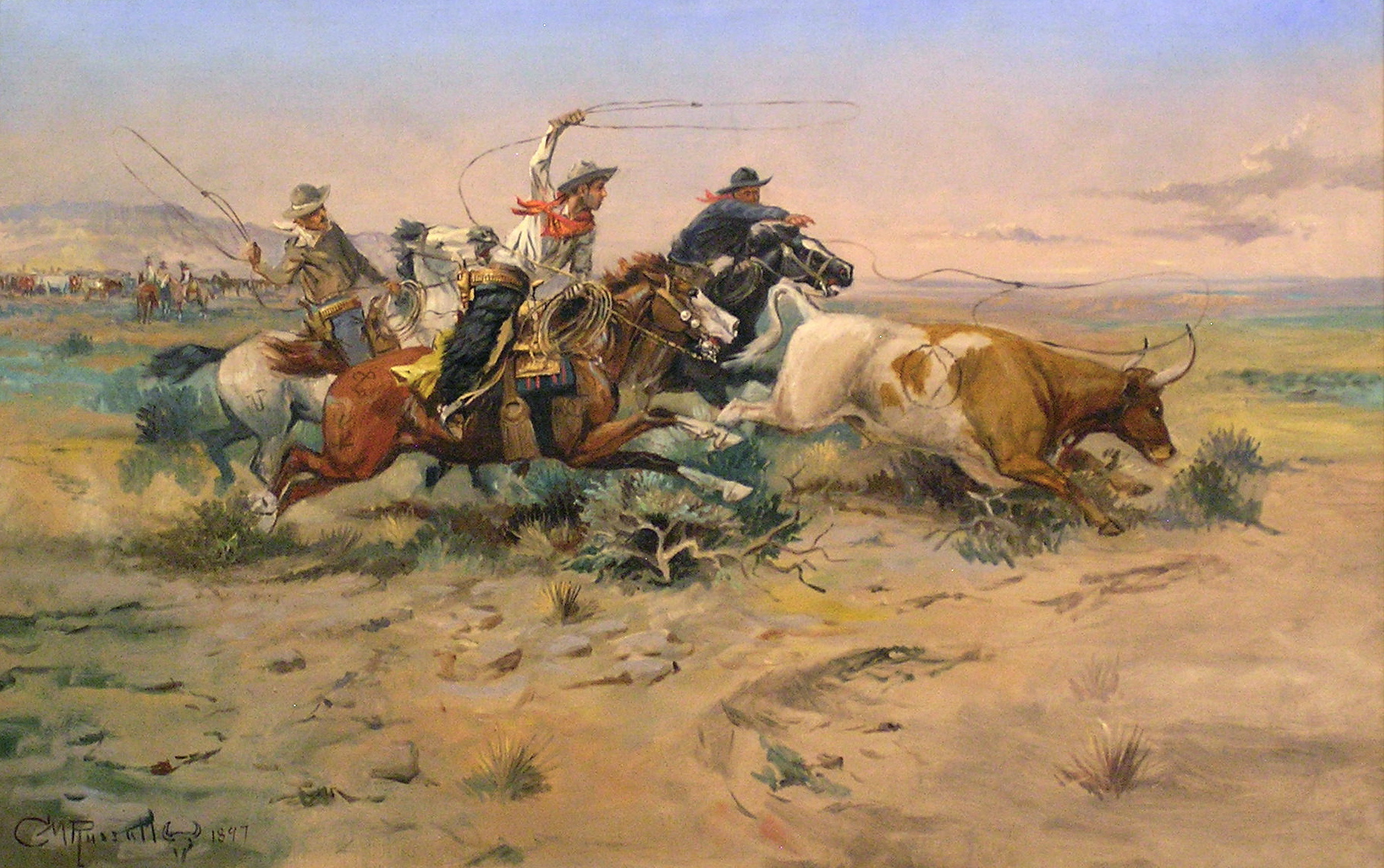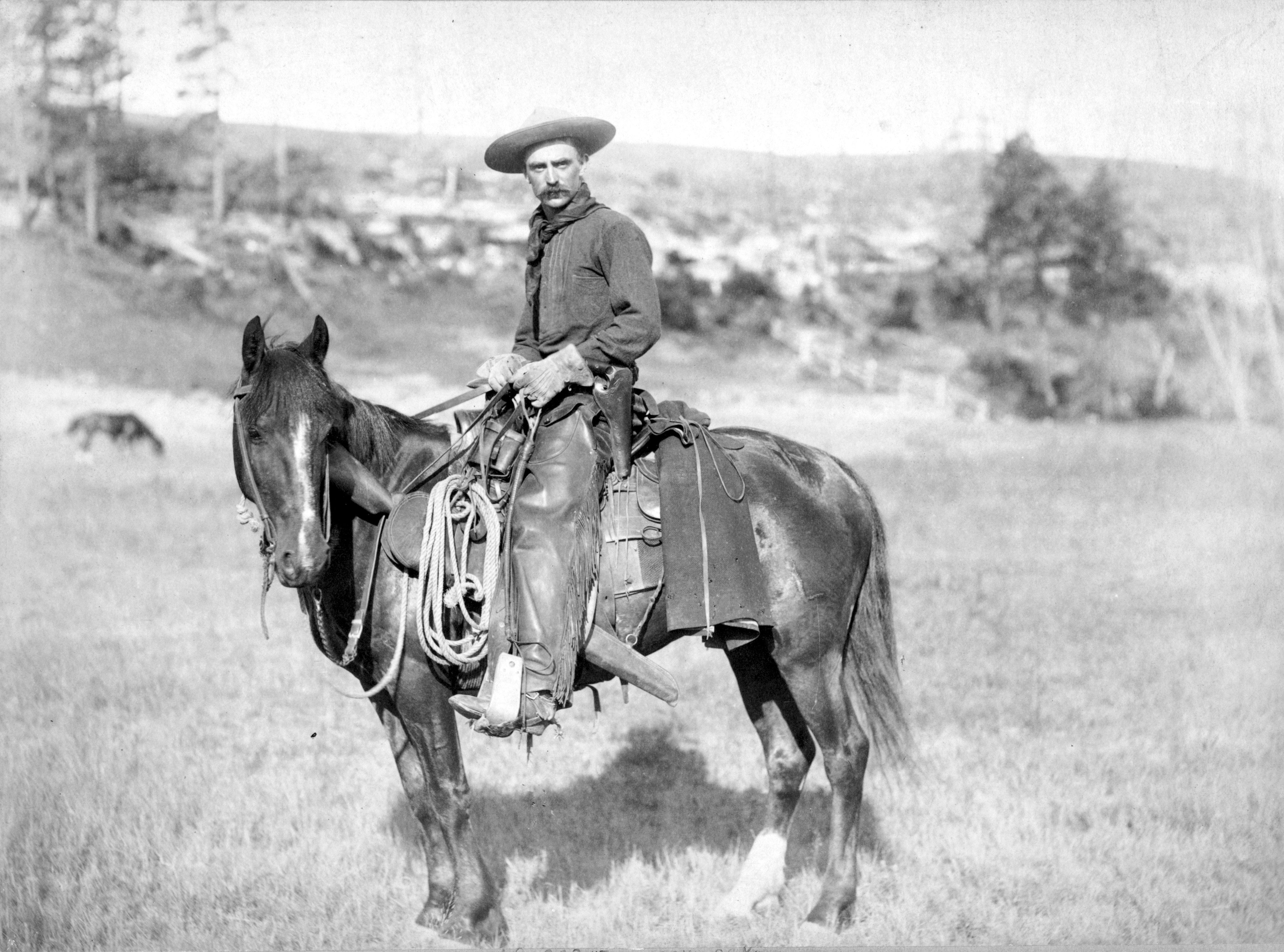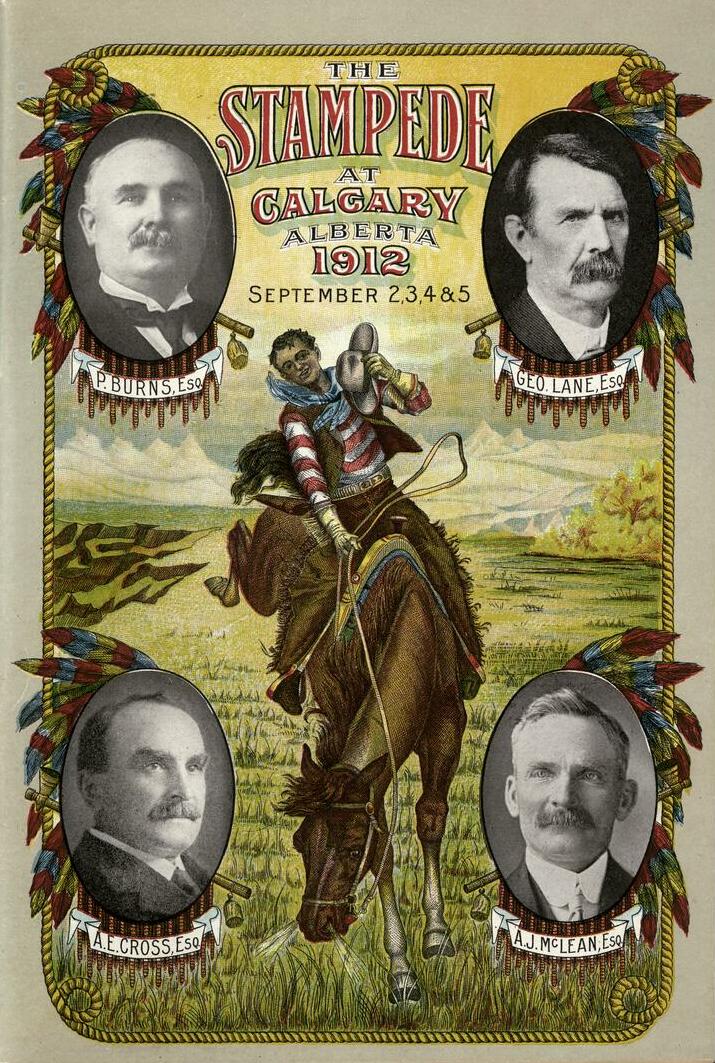|
Rodeos
Rodeo () is a competitive equestrian sport that arose out of the working practices of cattle herding in Spain and Mexico, expanding throughout the Americas and to other nations. It was originally based on the skills required of the working vaqueros and later, cowboys, in what today is the western United States, western Canada, and northern Mexico. Today, it is a sporting event that involves horses and other livestock, designed to test the skill and speed of the cowboys and cowgirls. American-style professional rodeos generally comprise the following events: tie-down roping, team roping, steer wrestling, saddle bronc riding, bareback bronc riding, bull riding and barrel racing. The events are divided into two basic categories: the Roughstock, rough stock events and the timed events. Depending on sanctioning organization and region, other events such as breakaway roping, goat tying, and pole bending may also be a part of some rodeos. The "world's first public cowboy contest" was h ... [...More Info...] [...Related Items...] OR: [Wikipedia] [Google] [Baidu] |
Cowboy
A cowboy is an animal herder who tends cattle on ranches in North America, traditionally on horseback, and often performs a multitude of other ranch-related tasks. The historic American cowboy of the late 19th century arose from the ''vaquero'' traditions of northern Mexico and became a figure of special significance and legend.Malone, J., p. 1. A subtype, called a wrangler, specifically tends the horses used to work cattle. In addition to ranch work, some cowboys work for or participate in rodeos. Cowgirls, first defined as such in the late 19th century, had a less-well documented historical role, but in the modern world work at identical tasks and have obtained considerable respect for their achievements. Cattle handlers in many other parts of the world, particularly South America and Australia, perform work similar to the cowboy. The cowboy has deep historic roots tracing back to Spain and the earliest European settlers of the Americas. Over the centuries, difference ... [...More Info...] [...Related Items...] OR: [Wikipedia] [Google] [Baidu] |
Cowgirls
A cowboy is an animal herder who tends cattle on ranches in North America, traditionally on horseback, and often performs a multitude of other ranch-related tasks. The historic American cowboy of the late 19th century arose from the '' vaquero'' traditions of northern Mexico and became a figure of special significance and legend.Malone, J., p. 1. A subtype, called a wrangler, specifically tends the horses used to work cattle. In addition to ranch work, some cowboys work for or participate in rodeos. Cowgirls, first defined as such in the late 19th century, had a less-well documented historical role, but in the modern world work at identical tasks and have obtained considerable respect for their achievements. Cattle handlers in many other parts of the world, particularly South America and Australia, perform work similar to the cowboy. The cowboy has deep historic roots tracing back to Spain and the earliest European settlers of the Americas. Over the centuries, differences i ... [...More Info...] [...Related Items...] OR: [Wikipedia] [Google] [Baidu] |
Saddle Bronc Riding
Bronc riding, either bareback bronc or saddle bronc competition, is a rodeo event that involves a rodeo participant riding a bucking horse (sometimes called a ''bronc'' or '' bronco'') that attempts to throw or buck off the rider. Originally based on the necessary buck breaking skills of a working cowboy, the event is now a highly stylized competition that utilizes horses that often are specially bred for strength, agility, and bucking ability. It is recognized by the main rodeo organizations such as the Professional Rodeo Cowboys Association (PRCA) and the International Professional Rodeo Association (IPRA). Description Each competitor climbs onto a horse, which is held in a small pipe or wooden enclosure called a bucking chute. When the rider is ready, the gate of the bucking chute is opened and the horse bursts out and begins to buck. The rider attempts to stay on the horse for eight seconds without touching the horse with their free hand. On the first jump out of t ... [...More Info...] [...Related Items...] OR: [Wikipedia] [Google] [Baidu] |
Professional Rodeo Cowboys Association
The Professional Rodeo Cowboys Association (PRCA) is the largest rodeo organization in the world. It sanctions events in the United States and Canada, with members from said countries, as well as others. Its championship event is the National Finals Rodeo (NFR). The PRCA is headquartered in Colorado Springs, Colorado, United States.''2018 PRCA Media Guide" "Introduction'', ''About the PRCA'', p. 6. History The organization was created in 1936 when a group of cowboys walked out of a rodeo at Boston Garden to protest the actions of rodeo promoter W.T. Johnson, who refused to add the cowboys' entry fees to the rodeo's total purse. Johnson finally gave in to the cowboys' demands, and the successful "strike" led to the formation of the Cowboys' Turtle Association. That name was chosen because, while they were slow to organize, when required they were unafraid to stick out their necks to get what they wanted, like turtles might do. Among the organizers was a woman, a four-time n ... [...More Info...] [...Related Items...] OR: [Wikipedia] [Google] [Baidu] |
Bull Riding
Bull riding is a rodeo sport that involves a rider getting on a bucking bull and attempting to stay mounted while the animal tries to buck off the rider. American bull riding has been called "the most dangerous eight seconds in sports." To receive a score, the rider must stay on top of the bull for eight seconds with the use of one hand gripped on a bull rope tied behind the bull's forelegs. Touching the bull or themselves with the free hand, or failing to reach the eight-second mark, results in a no-score ride. Depending on the bull riding organization and the contest, up to four judges might judge the rider and four judge the bull on their performance. For most organizations, a perfect score is 100 points. In general, most professional riders score in the neighborhood of the mid-70s to the high 80s. Outside of the United States, bull riding traditions with varying rules and histories also exist in Canada, Mexico, Belize, Guatemala, El Salvador, Honduras, Nicaragua, Costa Rica ... [...More Info...] [...Related Items...] OR: [Wikipedia] [Google] [Baidu] |
Women's Professional Rodeo Association
The Women's Professional Rodeo Association (WPRA) is one of the largest rodeo sanctioning bodies in the world and is open exclusively to women eighteen years of age and older. Headquartered in Colorado Springs, Colorado, the Association currently has over 3,000 members from all over the contiguous United States, Canada, and Australia. In 2004, WPRA members competed for nearly $5 million in total prize money at rodeos in the United States and co-sanctioned Canadian Professional Rodeo Association (CPRA) events in Canada. History Formed as the Girls Rodeo Association (GRA) in 1948, several of the original members were female ranchers who had been forced to take over family operations as husbands, fathers, and brothers were called to service in World War II. Though women had played an important role in rodeo's formative years in the mid-to-late nineteenth century, competing and winning against their male counterparts, by the time of the GRA's formation women's role in rodeo ... [...More Info...] [...Related Items...] OR: [Wikipedia] [Google] [Baidu] |
Calgary Stampede
The Calgary Stampede is an annual rodeo, exhibition, and festival held every July in Calgary, Alberta, Canada. The ten-day event, which bills itself as "The Greatest Outdoor Show on Earth", attracts over one million visitors per year and features one of the world's largest rodeos, a parade, midway, stage shows, concerts, agricultural competitions, chuckwagon racing, and First Nations exhibitions. In 2008, the Calgary Stampede was inducted into the ProRodeo Hall of Fame. The event's roots are traced to 1886 when the Calgary and District Agricultural Society held its first fair. In 1912, American promoter Guy Weadick organized his first rodeo and festival, known as the Stampede. He returned to Calgary in 1919 to organize the Victory Stampede in honour of soldiers returning from World War I. Weadick's festival became an annual event in 1923 when it merged with the Calgary Industrial Exhibition to create the Calgary Exhibition and Stampede. Organized by thousands of volunte ... [...More Info...] [...Related Items...] OR: [Wikipedia] [Google] [Baidu] |
Goat Tying
Goat tying is a rodeo event typically seen in youth, high school and college rodeos, in which the participant rides to a tethered goat, dismounts, catches, throws, and ties any three of its legs together. The goat must stay tied for six seconds after the contestant has backed away from the animal. If the goat becomes untied before six seconds have passed, the rider receives no score. A participant may be disqualified for undue roughness while handling the goat, touching the goat after the tie, or after signaling completion of the tie, or the contestant's horse coming in contact with the goat or tether while the contestant has control of the horse. The event is not seen in professional rodeo, but is a common event seen at youth, high school rodeo and intercollegiate rodeo levels. In most cases, it is considered a women's event. Event The object is to race to the end of the rodeo arena to a goat staked out on a rope, catch the goat, throw it to the ground and tie three of it ... [...More Info...] [...Related Items...] OR: [Wikipedia] [Google] [Baidu] |
Barrel Racing
Barrel racing is a rodeo event in which a horse and rider attempt to run a cloverleaf pattern around preset barrels in the fastest time. In collegiate and professional ranks, it is usually a women's event, though both sexes compete at amateur and youth levels. It requires a combination of the horse's athletic ability and the horsemanship skills of a rider in order to safely and successfully maneuver the horse around three barrels placed in a triangle pattern within a large arena. History Barrel racing originally developed as an event for women. In early barrel racing, the pattern alternated between a figure-eight and a cloverleaf pattern. The figure-eight was eventually dropped in favor of the more difficult cloverleaf. It is believed that competitive barrel racing was first held in Texas. The Women's Professional Rodeo Association (WPRA) was founded in 1948 by a group of women from Texas who were trying to find a place for women in the wider sport of rodeo. When it began, ... [...More Info...] [...Related Items...] OR: [Wikipedia] [Google] [Baidu] |
Steer Wrestling
Steer wrestling, also known as bulldogging, is a rodeo event in which a horse-mounted rider chases a steer, drops from the horse to the steer, then wrestles the steer to the ground by grabbing its horns and pulling it off-balance so that it falls to the ground. The event carries a high risk of injury to the cowboy. Some concerns from the animal-rights community express that the competition may include practices that constitute cruelty to animals, but the injury rate to animals is less than 0.05%. A later PRCA survey of 60,971 animal performances at 198 rodeo performances and 73 sections of "slack" indicated 27 animals were injured, again around 0.05%. Origins Historically, steer wrestling was not a part of ranch life. The event originated in the 1890s, and is claimed to have been started by an individual named Bill Pickett, a wild-west show performer said to have caught a runaway steer by wrestling it to the ground. The several versions of the story have some claiming that he ... [...More Info...] [...Related Items...] OR: [Wikipedia] [Google] [Baidu] |
Muster (livestock)
A muster (Au/NZ) or a roundup (US/Ca) is the process of gathering livestock. Musters usually involve cattle, sheep or horses, but may also include goats, camels, buffalo or other animals. Mustering may be conducted for a variety of reasons including routine livestock health checks and treatments, branding, shearing, lamb marking, sale, feeding and transport or droving to another location. Mustering is a long, difficult and sometimes dangerous job, especially on the vast Australian cattle stations of the Top End, 'The Falls' (gorge) country of the Great Dividing Range and the ranches of the western United States. The group of animals gathered in a muster is referred to as a "mob" in Australia and a "herd" in North America. Methods Mustering may be done on foot, with various vehicles, horses or with aircraft. Techniques in mustering cattle or sheep will depend on region, culture, distances and the type of terrain involved, and the type of animal that is being mustered. Most ... [...More Info...] [...Related Items...] OR: [Wikipedia] [Google] [Baidu] |
.jpg)


.jpg)


.jpg)
